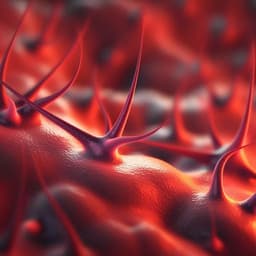
Medicine and Health
Ultra-conformal skin electrodes with synergistically enhanced conductivity for long-time and low-motion artifact epidermal electrophysiology
Y. Zhao, S. Zhang, et al.
Discover groundbreaking advancements in wearable healthcare with an ultra-thin dry epidermal electrode, developed by Yan Zhao, Song Zhang, and their team. This innovative technology ensures precise monitoring of electrophysiological signals while prioritizing comfort and minimizing motion artifacts, making it ideal for long-term health applications.
~3 min • Beginner • English
Introduction
The study addresses the need for comfortable, accurate, and long-duration epidermal electrophysiological monitoring. Conventional pregelled Ag/AgCl electrodes are bulky, can cause discomfort over long use, and are prone to motion artifacts due to gel drying and detachment. The authors propose an ultra-thin (~100 nm), transparent, and highly conductive dry skin electrode comprising a PEDOT:PSS film transferred onto CVD-grown graphene (PTG). The research hypothesis is that synergistic interactions between PEDOT:PSS and graphene will enhance conductivity and mechanical compliance, enabling conformal skin contact, reduced interfacial impedance, lower motion artifacts, and stable long-term recordings (including facial sEMG and EEG).
Literature Review
Prior work has explored conductive hydrogels, PEDOT:PSS films, and graphene-based electrodes for bioelectronic interfaces, but challenges remain in achieving high conductivity with ultra-thin, conformal, and mechanically stable dry electrodes. The authors compare their PTG approach to various PEDOT:PSS conductivity enhancement strategies (e.g., acid soaking, ionic liquid doping) reporting conductivities up to ~4100 S/cm in literature. They highlight limitations of commercial Ag/AgCl gel electrodes (noise and motion artifacts) and brittleness of pure PEDOT:PSS films under strain. Graphene has been used as transparent, flexible conductors; however, the present work emphasizes a synergistic PEDOT:PSS-graphene interface that increases molecular ordering and charge delocalization beyond PEDOT:PSS-only treatments, achieving superior conductivity with ultra-thin films suitable for epidermal applications.
Methodology
Materials: PEDOT:PSS (Clevios PH 1000), sodium dodecyl sulfate (SDS, 0.25–1.5 wt% as surfactant), butyl sulfone (BSL, ionic additive), SEBS elastomer, decal transfer paper. Fabrication: Monolayer graphene grown on both sides of Cu foil by CVD (H2 20 sccm, CH4 35 sccm, 1000 °C, 40 min). PEDOT:PSS solution modified with SDS (stir 2 h) and BSL (stir additional 2 h), filtered (0.45 µm PES), spin-coated (2000 rpm, 60 s) on graphene/Cu, forming PEDOT:PSS/graphene/Cu. Anneal at 120 °C, etch Cu with (NH4)2S2O8 (~2 h), rinse, and transfer PEDOT:PSS/graphene (PTG) onto desired substrates (silicon, glass, tattoo paper, flexible substrates). Optimization: SDS optimized at 1.0 wt% to avoid precipitation (>1.0 wt% led to PEDOT:PSS aggregates). BSL increased conductivity; at 5.0 wt% BSL, conductivity reached ~4142 S/cm but solution gelation hindered uniform spin-coating; for balanced performance in epidermal tests, both SDS and BSL at 1.0 wt% with bi-layer graphene were chosen. Characterization: Four-probe sheet resistance (Keithley 2400), UV–vis transmittance, AFM (tapping mode) for morphology and Young’s modulus mapping, GIWAXS (Xeuss 2.0, λ=1.54 Å, incidence 0.2°) for molecular packing and π–π stacking distance, Raman (532 nm) for PEDOT and graphene peak shifts, UV–vis–NIR for charge delocalization, ESR for polaron/bipolaron states, EIS for skin-electrode interfacial impedance. Mechanical tests: Bending on PET (radii 12–2 mm) and tensile strain on SEBS (up to 40%) monitoring resistance changes; AFM morphology before/after 20% strain to assess cracking/wrinkling. Electrophysiology: sEMG (two working electrodes on forearm, reference on wrist), ECG (Einthoven triangle placements on arm), EOG (forehead and lower eyelids). Signals recorded with DueLite system; sEMG filtered by 6th-order Butterworth (10–450 Hz). Motion artifact: Induced by electromechanical vibrator placed ~2 cm from electrodes; baseline noise and SNR assessed in static vs dynamic conditions. Facial sEMG and LSCI: PTG pairs on facial muscles (levator labii superioris alaeque nasi; also zygomaticus, risorius, corrugator); Ag/AgCl or PEDOT:PSS as controls on contralateral side; LSCI performed with SIM BFI-WF (FOV up to 14.8×14.8 cm). Robotic control: sEMG converted to PWM to drive servo motors for a robotic hand; multi-channel mapping from finger/facial muscle signals to finger/wrist movements. Long-term EEG: Two PTG working electrodes at Fp1/Fp2 and one reference behind ear; continuous 12 h monitoring across sleeping (~1 h), exercising (~0.5 h), and calm states without removing electrodes; FFT analysis to extract alpha (8–13 Hz) and beta (13–30 Hz) bands; impedance stability assessed over time.
Key Findings
- Ultra-thin and conductive PTG dry electrodes: thickness ~100 nm (~80–100 nm reported), sheet resistance ~24 Ω/sq, conductivity up to ~4142 S/cm with transparency suitable for epidermal use. At equal thickness (~80 nm), PTG conductivity (~2850 S/cm, 1G) was ~2× that of pure PEDOT:PSS (~1620 S/cm).
- Additive optimization and synergy: SDS (optimal ~1.0 wt%) and BSL improved conductivity; excessive SDS (>1.0 wt%) caused precipitation; high BSL (5.0 wt%) maximized conductivity but led to gelation and thicker films. Interfacing PEDOT:PSS with graphene further enhanced molecular ordering and charge transport via strong π–π interaction.
- Spectroscopic and structural evidence of synergy:
• Raman: PEDOT C=C symmetric stretch shifted from 1434.5 cm−1 (pristine) to 1431.6 (SDS), 1432.4 (SDS+BSL), and further to 1438.9 cm−1 in PTG; graphene G-band shifted from 1586.4 to 1599.5 cm−1 in PTG, indicating strong interaction and charge transfer.
• UV–vis–NIR: Increased absorbance at ~800 nm and NIR free-carrier tail in PTG, indicating polaron-to-bipolaron formation and charge delocalization.
• ESR: Strong signals in pristine PEDOT:PSS (localized polarons) markedly reduced in PTG (delocalized bipolarons).
• GIWAXS: PEDOT π–π stacking distance decreased from 3.54 Å (pristine) to 3.37 Å (PTG with SDS+BSL), among the smallest reported for solution-processed PEDOT, indicating tighter packing and higher crystallinity.
• AFM: Morphology transitioned from granules (PEDOT:PSS) to nanofibrils (PTG) with 2–3× increased surface roughness; upon 20% strain, fewer cracks and subtler wrinkles in PTG vs PEDOT:PSS, consistent with improved mechanical/electrical stability due to graphene.
- Mechanical/electrical stability: Minimal resistance change under bending (radii 12→2 mm). On SEBS, PTG with more graphene layers showed improved strain tolerance; tri-layer PTG maintained resistance as low as ~1680 Ω at 40% strain.
- Skin conformability and impedance: PTG Young’s modulus ~640 kPa (close to stratum corneum ~150 kPa) and ultra-thin geometry yield bending stiffness comparable to skin. Interfacial impedance at 100 Hz: PTG ~32 kΩ vs PEDOT:PSS ~42 kΩ and Ag/AgCl ~45 kΩ.
- Electrophysiology performance:
• EOG and ECG: Clear, comparable signals among PTG, PEDOT:PSS, and Ag/AgCl; characteristic ECG waves (P, QRS, T) identifiable.
• sEMG quality: Static SNR (mean±SD): PTG 23±0.7 dB vs Ag/AgCl 19±0.5 dB and PEDOT:PSS 18±0.5 dB. Dynamic baseline noise: PTG 23±2.9 µV vs Ag/AgCl 38.8±2.8 µV and PEDOT:PSS 41.2±3.2 µV; dynamic SNR: PTG 21±0.3 dB vs Ag/AgCl 14±0.4 dB and PEDOT:PSS 13±0.4 dB.
• Motion artifacts: PTG exhibited the lowest motion artifact in sEMG and ECG under induced vibration.
• Control applications: Multi-channel sEMG via PTG reliably drove a robotic hand to perform gestures (e.g., victory, numerals, grasping), including from facial sEMG (zygomaticus, risorius, corrugator).
• Facial measurements with imaging: PTG’s transparency enabled concurrent facial sEMG and laser speckle contrast imaging (LSCI) at the same site; blood perfusion measurable under PTG but not under opaque Ag/AgCl.
• Long-term EEG: Continuous 12 h monitoring across sleeping, exercising, and calm states without electrode removal; stable signal quality despite sweating and motion; FFT revealed stronger alpha and beta bands during exercise relative to sleep and calm, consistent with higher arousal/attention. Contact impedance at 10 Hz remained stable over time (Supplementary data).
Discussion
The work demonstrates that synergistic π–π interactions and charge transfer at the PEDOT:PSS–graphene interface produce tighter PEDOT packing and delocalized charge carriers, thereby achieving high conductivity in ultra-thin films. The resulting PTG electrodes conform intimately to skin due to low thickness and moderate modulus, reducing interfacial impedance and motion-induced artifacts. This directly addresses challenges of conventional gel electrodes (comfort, gel drying, displacement) and brittle PEDOT:PSS-only films, enabling accurate electrophysiological measurements (EOG, ECG, sEMG) even under motion. Transparency allows multimodal facial assessments by combining sEMG with LSCI. The electrodes’ mechanical and electrical stability support stable 12 h EEG monitoring through diverse activities. These advances position PTG as a promising platform for wearable healthcare and human–machine interfacing, including robust sEMG-driven control of robotic devices and long-duration EEG acquisition.
Conclusion
The study introduces an ultra-thin, transparent, and highly conductive dry epidermal electrode formed by transferring PEDOT:PSS onto CVD graphene (PTG). Through strong PEDOT–graphene π–π interactions, PTG achieves record-high conductivity for such thin films (~4142 S/cm), tight molecular packing, and excellent mechano-electrical stability. The electrodes conform to skin, exhibit low interfacial impedance, reduce motion artifacts, and enable accurate electrophysiological monitoring: high-quality sEMG (including facial), ECG/EOG, concurrent facial LSCI, robust robotic control via sEMG, and continuous 12 h EEG recording across varied activities. These results suggest PTG as a compelling skin-electrode candidate for future wearable healthcare and human–machine interfaces. Potential future work includes scaling fabrication, optimizing additive concentrations and layer configurations for specific applications, and broader validation in clinical settings and complex control systems.
Limitations
- Additive trade-offs: While BSL at 5.0 wt% yields peak conductivity (~4142 S/cm), solution gelation at high BSL concentrations obstructs uniform spin-coating and can increase film thickness; SDS concentrations above ~1.0 wt% induce precipitation and surface roughness.
- Optimization balance: Achieving simultaneous transparency, conductivity, and mechano-electrical stability necessitated selecting bi-layer graphene with 1.0 wt% SDS and 1.0 wt% BSL, potentially below the maximum achievable conductivity.
- Mechanical limits: Electrical stability demonstrated up to ~40% tensile strain (with tri-layer graphene); performance beyond this strain was not established.
- Controls: Pure PEDOT:PSS films were brittle and failed under strain, limiting their utility as controls in dynamic tests; some measurements used auxiliary substrates (SEBS or tattoo paper) and evaporated Ag connections, which may influence handling but were necessary for stable interfacing.
Related Publications
Explore these studies to deepen your understanding of the subject.







